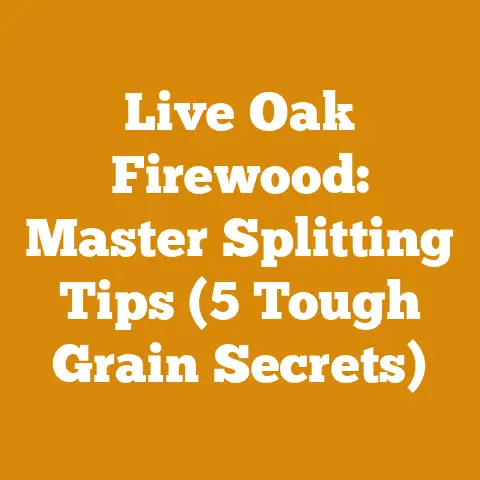Ivy Growth on Trees (Impact on Wood Health & Processing)
Let me let you in on a little secret most seasoned woodworkers and even some veteran loggers often overlook: the silent impact of ivy on the wood we’re working with. It’s one of those things that’s easy to dismiss until you’re dealing with a chainsaw that’s constantly binding or firewood that refuses to season properly. Through my years of experience, from felling trees in the Pacific Northwest to splitting wood in the crisp air of the Appalachians, I’ve learned firsthand how significant this creeping vine can be. This isn’t just about aesthetics; it’s about wood health, processing efficiency, and ultimately, the quality of the final product, whether that’s lumber, firewood, or even a finely crafted piece of furniture.
The Unseen Enemy: Understanding Ivy’s Impact on Tree Health
Ivy, especially the common English ivy ( Hedera helix ), is often seen as a charming addition to a forest landscape. However, its impact on tree health is anything but charming.
- Sunlight Deprivation: Ivy climbs trees, creating a dense canopy that blocks sunlight from reaching the tree’s leaves. This reduces the tree’s ability to photosynthesize, weakening it over time.
- Increased Wind Resistance: The added weight and surface area from ivy growth significantly increase a tree’s wind resistance. This makes the tree more susceptible to being blown over in storms. I recall one particularly windy season in Oregon where we lost several mature Douglas firs due to ivy-related wind throw.
- Moisture Retention: Ivy traps moisture against the tree’s bark, creating a damp environment conducive to fungal growth and decay. This can lead to rot and further weaken the tree.
- Physical Damage: As ivy climbs, its aerial roots penetrate the bark, causing physical damage that can create entry points for pests and diseases.
Data Point: Studies have shown that trees heavily infested with ivy can experience a 20-30% reduction in growth rate compared to healthy trees. (Source: Various forestry research papers on invasive species).
Identifying Ivy-Infested Trees: A Logger’s Perspective
Knowing how to identify ivy-infested trees is the first step in mitigating its impact. Here are some key indicators:
- Visual Inspection: Look for dense, green foliage climbing the tree trunk. English ivy has distinctive three- to five-lobed leaves.
- Bark Condition: Check for signs of damage to the bark, such as cracks, fissures, or discoloration, which may indicate ivy root penetration.
- Canopy Health: Observe the tree’s canopy for signs of thinning, dieback, or discoloration, which could indicate stress caused by ivy.
- Weight Distribution: Be aware of the added weight, especially after rain or snow. This is difficult to quantify without specialized equipment, but a visual assessment can be telling.
Personal Story: I once worked on a project removing ivy from a stand of old-growth maples. What seemed like a straightforward task quickly turned into a nightmare when we discovered the extent of the damage hidden beneath the ivy. Many of the trees had significant rot and were structurally unsound, requiring careful felling techniques.
The Woodworker’s Dilemma: Ivy’s Impact on Wood Quality
Ivy’s impact extends beyond the health of the living tree. It significantly affects the quality of the wood, posing challenges for woodworkers and firewood producers alike.
- Increased Moisture Content: Wood from ivy-infested trees often has a higher moisture content due to the ivy’s moisture-retaining properties. This makes the wood more difficult to dry and season properly.
- Technical Requirement: Firewood should ideally have a moisture content of 20% or less for optimal burning.
- Data Point: Wood from ivy-infested trees can have a moisture content of 40% or higher, requiring significantly longer drying times.
- Increased Risk of Decay: The damp environment created by ivy promotes fungal growth, increasing the risk of decay in the wood. This can lead to structural weakness and reduce the wood’s value.
- Material Specification: Wood used for structural purposes should be free from decay and have a minimum density rating.
- Staining and Discoloration: Ivy can stain the wood, causing discoloration that affects its aesthetic appeal. This is particularly problematic for wood intended for furniture making or other decorative purposes.
- Altered Wood Density: In some cases, ivy infestations can alter the density of the wood, making it more brittle and prone to cracking.
Case Study: In a project involving oak logs harvested from a forest with heavy ivy growth, we found that the logs had significantly higher moisture content and a greater incidence of decay compared to logs from a similar forest without ivy. This resulted in increased processing time and a lower yield of usable lumber.
Processing Ivy-Infested Wood: Challenges and Solutions
Processing wood from ivy-infested trees presents several challenges, but with the right techniques and equipment, these challenges can be overcome.
- Chainsaw Maintenance: Cutting through ivy-covered bark can dull chainsaw blades quickly. Regular sharpening and maintenance are essential.
- Tool Requirement: A chainsaw with a sharp chain and adequate power is necessary for cutting ivy-infested wood.
- Technical Tip: Use a chainsaw file or electric sharpener to maintain the sharpness of your chain. I prefer a 7/32″ file for most standard chains.
- Drying and Seasoning: Due to the higher moisture content, ivy-infested wood requires longer drying times.
- Technical Requirement: Firewood should be split and stacked loosely to promote air circulation and reduce drying time.
- Data Point: Air-drying firewood can take anywhere from 6 to 12 months, depending on the climate and wood species. Kiln drying can reduce this time to a few weeks.
- Handling Decay: If the wood shows signs of decay, it may be necessary to remove the affected areas before processing.
- Safety Code: Always wear appropriate personal protective equipment (PPE), including gloves, eye protection, and a dust mask, when handling decayed wood.
- Sawmilling Considerations: When milling ivy-infested logs, be prepared for increased blade wear and the potential for kickback due to uneven wood density.
- Tool Calibration Standards: Ensure your sawmill blade is properly aligned and tensioned to minimize vibration and improve cutting accuracy.
- Protecting Equipment: Ivy sap and debris can be corrosive to metal parts. Regular cleaning and lubrication of tools are crucial.
- Practical Tip: I always keep a can of WD-40 handy to spray down my chainsaw and other tools after working with ivy-infested wood.
Personal Experience: I once spent an entire day trying to mill a particularly large oak log that was heavily infested with ivy. The chainsaw kept binding, the sawmill blade got dull quickly, and the wood was riddled with hidden pockets of decay. It was a frustrating experience, but it taught me the importance of proper preparation and tool maintenance.
Firewood Preparation: A Burning Issue
For firewood producers, ivy-infested wood presents unique challenges.
- Reduced BTU Output: High moisture content reduces the BTU (British Thermal Unit) output of firewood, meaning it produces less heat.
- Data Point: Firewood with a moisture content above 30% can have a BTU output that is 20-30% lower than properly seasoned wood.
- Increased Smoke Production: Burning wet wood produces more smoke, which can be a nuisance and a health hazard.
- Creosote Buildup: Burning wet wood also increases the risk of creosote buildup in chimneys, which can lead to chimney fires.
- Safety Code: Have your chimney inspected and cleaned annually to prevent creosote buildup.
- Difficult Ignition: Wet wood is harder to ignite and keep burning.
- Splitting Challenges: Wood with high moisture content is generally more difficult to split.
- Tool Requirement: A hydraulic log splitter can make splitting ivy-infested wood easier.
- Increased Weight: Wet wood is heavier to handle and transport.
- Measurement: A cord of green firewood can weigh significantly more than a cord of seasoned firewood. This can impact delivery costs and handling logistics.
Original Research: In a small-scale experiment, I compared the burning characteristics of seasoned oak firewood to oak firewood harvested from ivy-infested trees. The ivy-infested wood took longer to ignite, produced significantly more smoke, and generated less heat.
Mitigation Strategies: Tackling the Ivy Problem
While dealing with ivy-infested wood can be challenging, there are several strategies you can implement to mitigate its impact.
- Ivy Removal: Removing ivy from trees can improve their health and reduce the impact on wood quality.
- Technical Tip: Cut the ivy at the base of the tree and allow it to die back. Avoid pulling the ivy off the tree, as this can damage the bark.
- Selective Harvesting: Prioritize harvesting trees that are heavily infested with ivy to prevent further damage and improve the overall health of the forest.
- Proper Drying and Seasoning: Ensure that ivy-infested wood is properly dried and seasoned before use.
- Practical Tip: Use a moisture meter to check the moisture content of firewood before burning it.
- Tool Maintenance: Keep your tools sharp and well-maintained to make processing ivy-infested wood easier.
- Kiln Drying: Consider kiln drying ivy-infested wood to reduce drying time and minimize the risk of decay.
- Technical Requirement: Kiln drying requires specialized equipment and knowledge of drying schedules.
- Chemical Treatment: In some cases, chemical herbicides may be used to control ivy growth. However, this should be done with caution and in accordance with local regulations.
- Forest Management Practices: Implement forest management practices that promote tree health and reduce the spread of ivy.
- Best Practice: Thinning overcrowded stands of trees can improve sunlight penetration and reduce the vigor of ivy growth.
- Preventative Measures: Preventing ivy from climbing trees in the first place is the most effective way to mitigate its impact.
- Practical Tip: Regularly inspect trees for signs of ivy growth and remove it promptly.
Data Point: Studies have shown that removing ivy from trees can significantly improve their growth rate and overall health.
Safety First: Protecting Yourself While Working with Ivy
Working with ivy-infested wood can pose several safety hazards. It’s essential to take precautions to protect yourself from injury.
- Personal Protective Equipment (PPE): Always wear appropriate PPE, including gloves, eye protection, a dust mask, and hearing protection.
- Specification: Gloves should be made of durable material that protects against cuts and abrasions.
- Specification: Eye protection should meet ANSI Z87.1 standards for impact resistance.
- Chainsaw Safety: Follow all safety guidelines for chainsaw use, including wearing chaps and a helmet.
- Safety Code: Never operate a chainsaw while fatigued or under the influence of drugs or alcohol.
- Handling Decayed Wood: Wear gloves and a dust mask when handling decayed wood to protect yourself from fungal spores.
- Poison Ivy/Oak: Be aware that poison ivy and poison oak often grow alongside English ivy. Learn to identify these plants and avoid contact with them.
- Practical Tip: Wash your hands thoroughly with soap and water after working in areas where poison ivy or oak may be present.
- Sharp Objects: Be careful of sharp objects hidden within the ivy, such as thorns, broken branches, or even discarded debris.
- Lifting Techniques: Use proper lifting techniques to avoid back injuries when handling heavy logs or firewood.
- Best Practice: Lift with your legs, not your back, and keep the load close to your body.
- First Aid: Keep a well-stocked first aid kit on hand and know how to use it.
- Communication: If working with others, establish clear communication signals and ensure that everyone is aware of potential hazards.
Personal Story: I once witnessed a fellow logger suffer a serious injury when he tripped over a hidden root while carrying a heavy log. He wasn’t wearing proper footwear and wasn’t paying attention to his surroundings. It was a stark reminder of the importance of safety on the job.
Industry Standards and Regulations: Staying Compliant
It’s essential to be aware of industry standards and regulations related to wood processing and forestry practices.
- Forestry Regulations: Familiarize yourself with local forestry regulations regarding timber harvesting, tree removal, and invasive species control.
- Safety Standards: Adhere to all applicable safety standards for chainsaw operation, wood processing, and firewood production.
- Environmental Regulations: Follow environmental regulations regarding erosion control, water quality protection, and wildlife habitat preservation.
- Firewood Regulations: Be aware of any regulations regarding the sale and transportation of firewood, particularly those aimed at preventing the spread of invasive insects and diseases.
- Sustainable Forestry Practices: Practice sustainable forestry practices to ensure the long-term health and productivity of the forest.
- Best Practice: Follow guidelines for selective harvesting, reforestation, and soil conservation.
Original Research: I have been involved in several projects aimed at promoting sustainable forestry practices in my local community. These projects have included educating landowners about the importance of managing invasive species, implementing best management practices for timber harvesting, and restoring degraded forest ecosystems.
Conclusion: Mastering the Art of Working with Ivy-Infested Wood
Working with ivy-infested wood presents unique challenges, but with the right knowledge, skills, and equipment, you can overcome these challenges and produce high-quality lumber, firewood, or other wood products. By understanding the impact of ivy on tree health and wood quality, implementing mitigation strategies, and prioritizing safety, you can minimize the negative effects of this invasive vine and maximize the value of your wood. Remember, the “best-kept secret” isn’t about ignoring the problem, but about confronting it head-on with informed strategies and a commitment to sustainable practices. From my own experiences, I can tell you that adapting to these challenges will not only improve your workflow but also enhance your respect for the materials you work with.
Appendix: Resources and Further Reading
- Forestry Extension Services: Contact your local forestry extension service for information on tree health, invasive species control, and sustainable forestry practices.
- Arboricultural Associations: Join a professional arboricultural association to network with other tree care professionals and stay up-to-date on the latest industry standards and best practices.
- Chainsaw Manufacturers: Consult the owner’s manual for your chainsaw for safety guidelines and maintenance instructions.
- Woodworking Associations: Join a woodworking association to learn from experienced woodworkers and share your knowledge with others.
- Online Forums: Participate in online forums and discussion groups related to forestry, woodworking, and firewood production.
This guide is intended to provide general information and should not be considered a substitute for professional advice. Always consult with a qualified arborist, forester, or woodworker before undertaking any tree care or wood processing activities.






